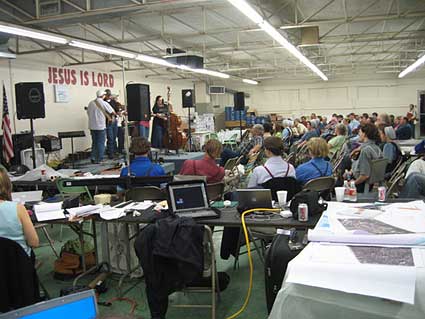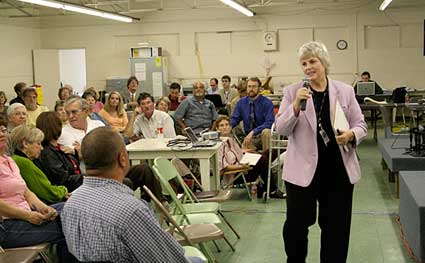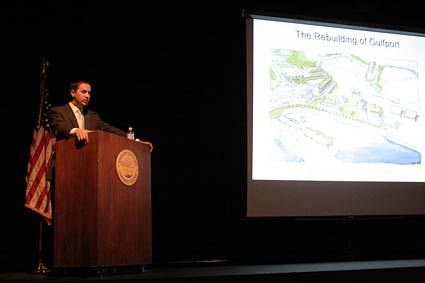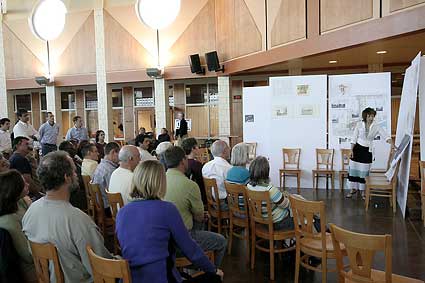|
|
 |
 |


By Jason Miller and Laurence Aurbach
April 26, 2006 --
Half a year after the Renewal Forum, participants are continuing a sustained involvement with the rebuilding of Mississippi's coastal cities and neighborhoods. Numerous workshops and seminars have been given to introduce and explain new urbanist codes, specifically the Mississippi Model SmartCode which is being customized for individual cities.
Of the 11 cities addressed by the Renewal Forum, four have taken active steps to implement the SmartCode, while another six are giving strong consideration to implementing the SmartCode. Meanwhile, designs for new cottages are being produced by various Forum architects and several have begun construction.
Here's a recap, with details of what's been accomplished over the past several months:
A model village is planned for Ocean Springs. Six partners, including designer Marianne Cusato and local architect Bruce Tolar, are forming a for-profit development group to buy a parcel in Ocean Springs on Government Street, within walking distance of the historic downtown. The current site plan is a small village around a park, and calling for 17 Katrina cottages designed by new urbanist architects.
The cottages will represent various forms of construction, from stick-built to panelized to modular to full factory-made and delivered (a la the standard mobile home). Square-footage ranges from the original Katrina Cottage at 300 square feet to models at least four times that size. Some live-work designs and cottage retail designs are also included, though those may have to wait for a more appropriate model opportunity.
The current strategy is to make the model village a permanent site, with underground utilities, sewer and water. The models, supplied by various manufacturers, will be on display for a couple of years. Then the units are sold and/or leased, and the village becomes a real neighborhood.
It’s likely there will be some kind of Design Center, probably a non-profit that leases space from the developers, although that’s not entirely worked out.
The Pass Christian SmartCode charrette took place Feb. 15–19 and resulted in a draft SmartCode. The Planning Commission is currently reviewing this draft in public hearings and expects to present a final draft to the Mayor and Board of Aldermen by May 15. Wal-Mart continues to move forward in the design of the Pass Christian Wal-Mart Village, and is partnering with HRI of New Orleans to develop the mixed-use housing portion of the project. Wal-Mart officials have expressed interest in incorporating new urbanist architects into the process.
While FEMA has rejected the use of "Katrina Cottages" as transitional housing in nearby Ocean Springs, Pass Christian's new downtown plan includes a number of cottage courts, raising expectations for a continued market for the Katrina cottages. One such cottage, designed by Eric Moser of South Carolina, is being built in the center of town and is one of the first to go up, providing an opportunity for greater exposure and potential for replication. Details on the Moser Katrina cottage are available here.
 The Pass Christian charrette takes a break to hear bluegrass performed by 15- and 16-year-old musicians. Photo by Sandy Sorlien.
The Pass Christian charrette takes a break to hear bluegrass performed by 15- and 16-year-old musicians. Photo by Sandy Sorlien.
 Architect Laura Hall leads the design team for the Pass Christian charrette. Photo by Sandy Sorlien.
Architect Laura Hall leads the design team for the Pass Christian charrette. Photo by Sandy Sorlien. |
The Gulfport Downtown Association (GDA) held a "mini-charrette" on January 19-20, inviting all downtown stakeholders and anyone with an interest in revitalizing the downtown area in the aftermath of Katrina to participate. The community response was overwhelming: With a target attendance of at least 50 active participants, more than 100 attended. Steve Coyle, with HDR, Inc., who was a member of the Gulfport team during the October charrette, facilitated the sessions.
Prior to charrette, each participant completed a survey identifying the top goals for Downtown and the greatest obstacles facing Downtown. Based on the survey results, the participants were split into groups and charged with identifying objectives and strategies for seven focus areas: historic preservation, harbor development, image and identity, arts and entertainment, housing, retail/office and transportation.
The charrette produced a vision of downtown, identified obstacles to that vision and proposed critical implementation strategies. The GDA began acting on the recommendations even before the charrette ended, seeking funding sources for the retail and office market studies, and preparing grant applications to hire staff to go to work on the strategies. Teams have been formed from the charrette participants to work with the city to implement as many of the goals as possible as quickly as possible.
 Gulfport City Councilman Brian Carriere introduces the final presentation. The school where Carriere teaches, Gulf Coast Community College, hosted the charrette in its spacious cafeteria for six days.
Gulfport City Councilman Brian Carriere introduces the final presentation. The school where Carriere teaches, Gulf Coast Community College, hosted the charrette in its spacious cafeteria for six days.
Photo by Sandy Sorlien.
 Architect Joanna Alimanestianu shows drawings at a pinup session.
Architect Joanna Alimanestianu shows drawings at a pinup session.
Photo by Sandy Sorlien. |
A charrette to continue development of a master plan for Long Beach was held March 19-23. Representatives from Washington, D.C.-based Ayers/Saint/Gross, Inc., joined new urbanists Jackie Benson and Todd Zimmerman to discuss marketing, branding and housing development opportunities. The charrette ended with a presentation of "the new, improved, Long Beach Master Plan."
A citizens' commission, with the assistance of Renewal Forum designers and consultants, is building on the original Renewal Forum plans through a series of workshops and charrettes. The commission's April charrette refined the master plan to reconfigure downtown streets and move City Hall and emergency services out of the flood plain, and also worked on customizing the SmartCode for Moss Point.
Commission chairman Steve Renfroe said the commission is seeking more participation to improve the proposals. The commission will present a final plan and code to the city within a few months.
In Pascagoula, a citizen's commission known as the Pascagoula Renaissance Commission (PRC) has submitted its recommendations to the city council. The PRC called for rezoning and adopting SmartCodes, saying the document's comprehensive approach is "key to the city's future."
The PRC recommended mandatory SmartCode zones in downtown, the historic district, riverfront and commercial areas along U.S. 90 and Market Street. Retaining and assisting small businesses should be a priority, said the PRC, and a city planner position should be created to help implement the SmartCode and coordinate development in the city.
The Renewal Forum team that created a plan for Biloxi, led by the firm of Moule and Polyzoides, has resigned from further work on the plan. Explaining their reasons for pulling out, the firm wrote: "Very simply, while we respect the rights of Biloxi officials to set priorities, we believe that the decisions that are now being made are outside of a holistic planning process -- accepting the FEMA maps/guidelines, allowing casino operators to drive infrastructure and design decisions, promoting unchecked real estate speculation and up-zoning -- are all incompatible with a community-based design approach."
Currently Biloxi has two groups working on planning initiatives. One group is focusing on East Biloxi (Ward 2) and the other, led by Mayor A.J. Holloway's Reviving the Renaissance Steering Committee, is addressing city-wide planning and rebuilding issues. A number of public meetings and charrettes have already been held and the Reviving the Renaissance report is due to be completed on May 31.
The Gulf Coast has seen much SmartCode activity in addition to the formal charrettes that have already taken place. Information sessions about the SmartCode were held in Gautier and Pascagoula in January 2006, and in Bay St. Louis, Waveland, and Moss Point in February 2006, followed by information sessions for the three coastal counties. A three-day, instructional SmartCode workshop was held in Biloxi in March. Supporting those events, the Mississippi Model SmartCode was published for free distribution to all of the coastal cities.
Renewal Forum transportation engineers have continued to be involved with Gulf Coast transportation planning. Engineers Rick Chellman and Norman Garrick have returned to Mississippi on several occasions and have provided extensive consulting services on a pro bono basis to Ocean Springs, the Governor's Commission, and others concerning various MDOT matters.
Katrina Cottages are making a new round of headlines. U.S. Senator Thad Cochran has proposed a pilot program to build 20,000 Katrina Cottages for Gulf Coast residents currently living in travel trailers. The Katrina Cottage design, which offers a safer, more comfortable and less expensive housing alternative, was created during the Mississippi Renewal Forum in October and has garnered much attention in the months since. The small houses are modeled after traditional Mississippi homes and can be expanded to eventually become permanent housing. The program's design parameters are being developed by a team of architects, builders and policy analysts. If the $1.2 billion program proves to be successful, it could revolutionize the way emergency housing is provided after disasters.
|
 |

|
 |

